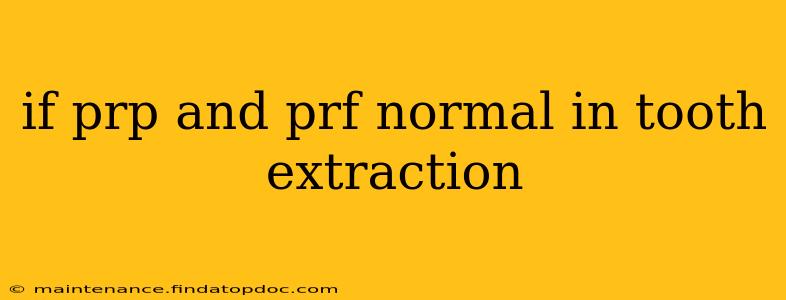Tooth extraction, while a common procedure, can sometimes leave patients wondering about the best ways to promote healing and minimize complications. Platelet-rich plasma (PRP) and platelet-rich fibrin (PRF) are two innovative therapies gaining popularity in oral surgery, offering potential benefits for faster healing and reduced inflammation after extractions. But are they "normal" or standard practice? Let's explore.
What are PRP and PRF?
Before we delve into their role in tooth extraction, let's understand what PRP and PRF are. Both are derived from the patient's own blood, making them autologous and minimizing the risk of allergic reactions or disease transmission.
-
Platelet-Rich Plasma (PRP): This concentrated solution contains a high number of platelets, which are blood cells crucial for clotting and wound healing. The process involves drawing blood, centrifuging it to separate the platelet-rich portion, and then injecting this PRP into the extraction site.
-
Platelet-Rich Fibrin (PRF): Similar to PRP, PRF is also derived from centrifuged blood. However, it's a less processed concentrate that includes fibrin, a protein that forms a natural scaffold for cell growth and tissue regeneration. This scaffold promotes better integration of the healing process.
Are PRP and PRF Standard Procedures After Tooth Extraction?
While PRP and PRF show promising results in accelerating healing and reducing complications after tooth extraction, they are not yet considered standard or routine procedures in all dental practices. Their use depends on several factors, including:
- The complexity of the extraction: Simple extractions often heal well without the need for additional therapies. More complex extractions, such as impacted wisdom teeth removals or extractions involving significant bone loss, might benefit more from these treatments.
- The patient's overall health: Patients with certain medical conditions or those taking medications that affect clotting may not be suitable candidates for PRP or PRF.
- The dentist's expertise and availability of technology: Administering PRP and PRF requires specialized equipment and training. Not all dental practices currently offer these therapies.
- Cost: PRP and PRF treatments can be more expensive than standard post-extraction care.
What are the Potential Benefits of Using PRP or PRF After Tooth Extraction?
The potential benefits of using PRP or PRF after tooth extraction are compelling, although more research is needed to establish definitive conclusions in all cases:
- Faster healing: The growth factors and proteins in PRP and PRF may stimulate faster tissue regeneration and bone formation.
- Reduced pain and inflammation: These therapies can help to reduce post-operative discomfort and swelling.
- Reduced risk of dry socket: A dry socket (alveolar osteitis) is a painful complication that can occur after tooth extraction. PRP and PRF may help to reduce the risk of developing this complication.
- Improved bone regeneration (in complex extractions): In cases of significant bone loss during extraction, PRP and PRF can support better bone healing and regeneration.
Does insurance typically cover PRP and PRF for tooth extraction?
Insurance coverage for PRP and PRF treatments after tooth extraction varies greatly depending on the insurance provider, the specific policy, and the justification for the procedure. It's crucial to check with your insurance company directly to understand your coverage before proceeding with treatment.
Are there any risks or side effects associated with PRP and PRF?
The risks associated with PRP and PRF are generally low, as they are derived from the patient's own blood. However, potential side effects might include:
- Mild pain or discomfort at the injection site.
- Minor bruising or swelling.
- Infection (although this is rare).
It's important to discuss any concerns with your dentist before undergoing these procedures.
Conclusion:
PRP and PRF are promising adjunctive therapies that may offer benefits for patients undergoing tooth extractions, particularly those involving complex procedures or individuals seeking faster healing and reduced complications. However, they are not yet a standard part of all tooth extraction protocols. The decision to use PRP or PRF should be made in consultation with your dentist, considering your individual needs, medical history, and the complexity of the extraction. Always discuss potential benefits, risks, and costs with your dental professional before making a decision.
